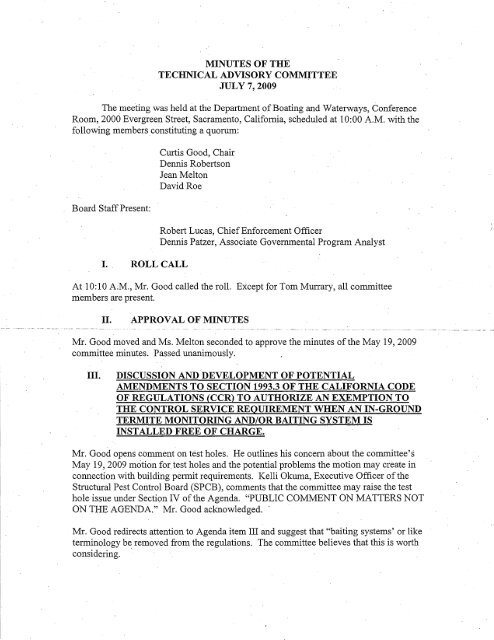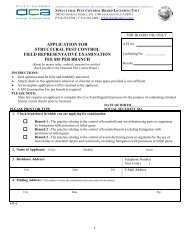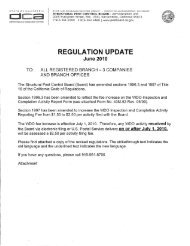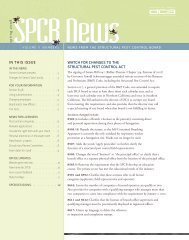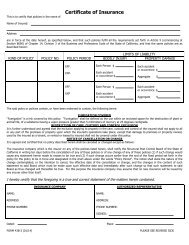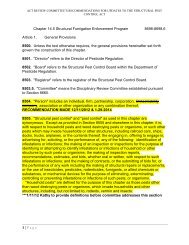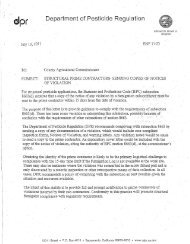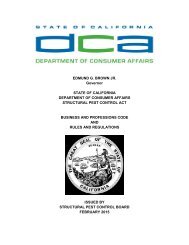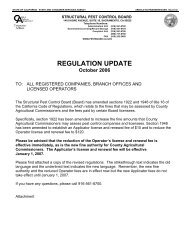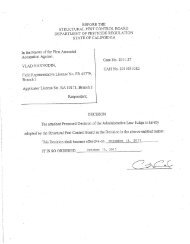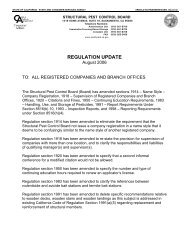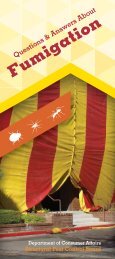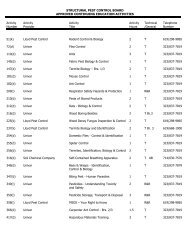Minutes - Structural Pest Control Board
Minutes - Structural Pest Control Board
Minutes - Structural Pest Control Board
You also want an ePaper? Increase the reach of your titles
YUMPU automatically turns print PDFs into web optimized ePapers that Google loves.
MINUTES OF THE<br />
TECHNICAL ADVISORY COMMITTEE<br />
JULY 7, 2009<br />
The meeting was held at the Department of Boating and Waterways, Conference<br />
Room, 2000 Evergreen Street, Sacramento, California, scheduled at 10:00 A.M. with the<br />
following members constituting a quorum:<br />
<strong>Board</strong> Staff Present:<br />
I. ROLLCALL<br />
Curtis Good, Chair<br />
Dennis Robertson<br />
Jean Melton<br />
David Roe<br />
Robert Lucas, Chief Enforcement Officer<br />
Dennis Patzer, Associate Governmental Program Analyst<br />
At 10:10 A.M., Mr. Good called the roll. Except for Tom Murrary, all committee<br />
members are present.<br />
II. APPROVAL OF MINUTES<br />
Mr. Good moved and Ms. Melton seconded to approve the minutes of the May 19,2009<br />
committee minutes. Passed unanimously.<br />
III. DISCUSSION AND DEVELOPMENT OF POTENTIAL<br />
AMENDMENTS TO SECTION 1993.3 OF THE CALIFORNIA CODE<br />
OF REGULATIONS (CCR) TO AUTHORIZE AN EXEMPTION TO<br />
THE CONTROL SERVICE REQUIREMENT WHEN AN IN-GROUND<br />
TERMITE MONITORING AND/OR BAITING SYSTEM IS<br />
INSTALLED FREE OF CHARGE.<br />
Mr. Good opens comment on test holes. He outlines his concern about the committee's<br />
May 19,2009 motion for test holes and the potential problems the motion may create in<br />
connection with building permit requirements. Kelli Okuma, Executive Officer ofthe<br />
<strong>Structural</strong> <strong>Pest</strong> <strong>Control</strong> <strong>Board</strong> (SPCB), comments that the committee may raise the test<br />
hole issue under Section IV ofthe Agenda. "PUBLIC COMMENT ON MATTERS NOT<br />
ON THE AGENDA." Mr. Good acknowledged. .<br />
Mr. Good redirects attention to Agenda item III and suggest that "baiting systems' or like<br />
terminology be removed from the regulations. The committee believes that this is worth<br />
considering. .
Committee member Dennis Robertson states the following in summary:<br />
We don't have a problem with detection. It is a function ofa Branch 3 since it is<br />
for termites. An inspection should be done within three years because people may<br />
get a false sense ifthere is no·problem. We do monitoring as a warranty program<br />
and it is fee based. I know that it is an added expense. The consumer is getting .<br />
more for their money and they understand that. We can justify the costs.<br />
Mr. Rowell believes that an inspection is required before the items can actual be installed.<br />
He continued that a three-year inspection should pose no issue.<br />
Mr. Good conceptualizes that if a Bnmch 3 performs an inspection and assuming noting<br />
is found, the customer can be given the option to elect for a CSA or detection program.<br />
Mr. Rowell continues about the number of devices installed maintaining that Orkin, Indc.<br />
Usually installs between six to eight devices while Terminix {as explained by Mr.<br />
Ennes} installs approximately eight devices.<br />
Mr. Ennes comments that he does not agree with the three-year inspection requirement<br />
because it can be cost prohibitive. However, he agrees that an initial inspection should<br />
take place prior to the installation of the devices.<br />
Mr. Good asked the significance of a full or limited inspection.<br />
Mr. Rowell comments that the inspection is consumer driven:-<br />
Mr. Robertson states that the <strong>Structural</strong> <strong>Pest</strong> <strong>Control</strong> Act allows either a full inspection or<br />
a limited inspection.<br />
Mr. Rowell states that three-year inspections add expense, but he believes this is a small<br />
compromise: He adds that some times the devices can fail and to replace them can add<br />
costs as well.<br />
Mr. Good states that customer perceptions about a CSA verses a detection agreement ·can<br />
be confusing. Additionally, companies may have an incorrect perception because current<br />
laws and regulations require a baiting or monitoring system and not a detection system.<br />
Mr. Rowell comments that a CSA requires that the customer pay for specific services at<br />
the beginning while a detection program is free of charge.<br />
The audience comments that consumer cannot be expected to understanCl the differences<br />
between the two programs especially since a CSA warrants against damage while a<br />
detection program is dedicated only to infestation.<br />
Bill Gaither questions how the program is to be administered if a customer cancels<br />
service or if the property is sold.
Mr. Patzer comments that not all companies may be providing such services in the same<br />
. manner; consistency will be a major problem especially since there are over2,000<br />
companies whose approaches may differ from Orkin or Terminix.<br />
Mr. Rowell stressed that detection service is free since no one is making identifications at<br />
the beginning. He reiterates that the customer will be monitoring for detection. If the<br />
device is later triggered, the Branch 3, who is contacted by the customer, makes the<br />
identification.<br />
Mr. Gaither responds to Mr. Patzer's earlier comment by stating in summary; "It sounds<br />
like you're saying that other companies out there are crooks?"<br />
Mr. Patzer responds that is not his intent. He further comments that in-ground devices, or<br />
any other devices used for detection, according to the laws and regulations, are CSA's.<br />
Companies must comply with the law.<br />
Ms. Okuma responds that the regulations, as written, do not exempt a company from a<br />
CSA even if it is customer driven.<br />
Mr. Good states he believes that 12-15 stations actually should be installed around homes<br />
and even as many as 24 to 30 stations. The placement ofjust two stations can be a<br />
problem. .' .<br />
Mr. Rowell suggests that detection and monitoring should be defined perhaps. He<br />
_ recounts that itis still his belief that the regulation already covers detection services.<br />
Mr. Patzer questions how a company can control false customer calls (i.e. company<br />
responds on week 1 and week 5) especially if it is repeated within the three-year period.<br />
Mr. Rowell states that detection is a protection program and companies should be able to<br />
minimize repeated calls.<br />
An audience member states that his customers (in the Bay area and central coast) want<br />
spot treatments only as opposed to full treatments.<br />
Mr. Good requests to poll the committee on whether a regulatory change is required.<br />
Ms. Melton states that the SPCB legal staff should review this issue first before further<br />
considerations are made.<br />
Mr. Good requests a vote on whether a legal review of 1993.3
Mr. Ennes responds that Terminix uses oral agreements only.<br />
The audience expresses concern about allowing the three-year mandatory inspection<br />
believing that it should be an option or upon request.<br />
Robert Lucas states that permissive language may be used.<br />
Mr. Gaither states that he prefers that inspections be an option.<br />
Mr. Lucas recites that there must be a distinction made between detection and monitoring<br />
and whether inspections should be an option.<br />
Mr. Patzer states that he located his notes. He states that his notes refer to adding<br />
subsection "c" to 1993.3 CCR. He reads, "This section does not apply to.the placement<br />
of detection devices after an initial inspection by a registered company has been made<br />
when activity in the device is determined and actual identification must be made by a<br />
· branch 3 licensee."<br />
,0<br />
Mr. Good requests· that the committee move to allow a review of 1993.3 CCR with legal<br />
counsel and to await an opinion before moving forward. The committee motioned<br />
unanimously.<br />
IV. PUBLIC COMMENT ONMATTERS NOT ON THE AGENDA<br />
Ms. Okuma states that the committee seeks to revise the issue of test holes.<br />
· Mr. Good states that the committee's May 19,2009 motion requires further evaluation,<br />
· based on Mr. Lucas' insight, that building code standards were not fully considered.<br />
Mr.Lucas states that provisions. under Title 24 of the Building Standards Code must be<br />
evaluated as to their relevance in connection with test holes. A review ofthe<br />
International Building Codes, the California Building Codes, the International Residential<br />
Codes, city and/or county codes adopted are necessary. Additionally, organizations<br />
responsible for drafting standards should be contacted and this includes, but may not be<br />
limited to the International Code Council, California Association ofBuilding Officials<br />
and the International Conference of Building Officials. Mr. Lucas states that SPCB staff<br />
has been collecting information and will be submitting that information prior to the next<br />
· TAC meeting. .<br />
The audience suggests that SPCB laws be amended to recognize the building<br />
department's requirements.<br />
Mr. Good, upon input from Mr. Lucas and Ms. Okuma, requests that the issue oftest<br />
holes and building code requirements be discussed, as an agenda item, at the upcoming


